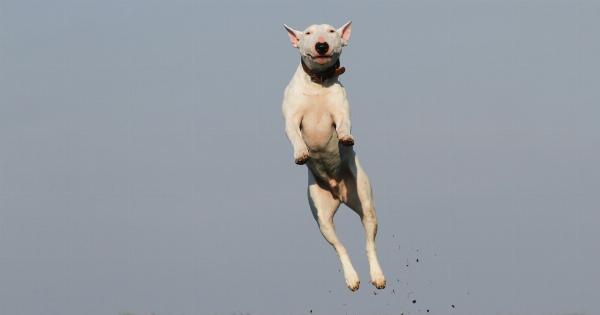Dogs have been our faithful companions for centuries, offering love, loyalty, and companionship. They are known for their incredible ability to communicate with us and with each other.
While humans primarily rely on verbal communication, dogs use a combination of body language, vocalizations, and facial expressions to convey their feelings and intentions. Understanding and decoding your dog’s actions can strengthen the bond between you and your furry friend while also ensuring their well-being and happiness.
1. Tail Wagging: More Than Just Happiness
One of the most iconic and easily recognizable dog behaviors is the wagging of their tail. It’s commonly associated with happiness and friendliness, but it’s essential to look beyond the wag itself.
The position and speed of the wag can convey different meanings. A high, fast wag generally indicates excitement or joy, while a slow wag with a lowered tail suggests caution or nervousness. It’s crucial to consider other accompanying body language to interpret your dog’s true emotions accurately.
2. Ear Positioning: Listening Closely
Dogs’ ears are incredibly expressive and can tell you a lot about how they are feeling. Upright and forward-facing ears usually indicate attentiveness or curiosity.
If the ears are pulled back or flattened against the head, it’s a sign of fear, submission, or insecurity. In some breeds with floppy ears, it may be more challenging to read ear position accurately. Pay close attention to their overall body language to better understand your dog’s intentions.
3. Eye Contact: The Window to Their Soul
Eye contact is a powerful form of communication in dogs. Staring directly into their owner’s eyes is often seen as a sign of trust and affection.
However, prolonged eye contact between dogs, especially in unfamiliar situations, can indicate aggression or a challenge. Some dogs may find direct eye contact intimidating, so it’s essential to be aware of their comfort levels. Understanding your dog’s eye contact can prevent misunderstandings and help you respond appropriately.
4. Vocalizations: Barks, Whines, and Growls
Dogs use various vocalizations to express their needs and emotions. Barking is the most common form of communication and can signify anything from excitement to warning or fear.
Whining or whimpering can indicate stress, discomfort, or a request for attention. A low growl, on the other hand, is a warning sign that your dog feels threatened or is displaying aggression. Pay attention to the context and the accompanying body language to understand the specific message your dog is trying to convey.
5. Body Posture: The Power of Positioning
Dogs communicate a great deal through their body language. The way they position themselves can reveal a range of emotions. A confident and assertive dog will stand tall, with their head held high.
On the other hand, a submissive or fearful dog will lower their body, tuck their tail, and may even roll onto their back, exposing their belly. Understanding the subtleties of your dog’s body posture is crucial in ensuring their comfort and recognizing any signs of distress.
6. Licking and Tail Tucking: Anxiety and Stress
Dogs may lick their lips or nose when they are feeling anxious or stressed. It’s a self-soothing behavior that helps them cope with their emotions.
Similarly, tucking their tail between their legs is a clear sign that your dog is feeling scared or threatened. These actions are indicators that your dog may need comforting or an opportunity to retreat to a safe and secure environment. Be attuned to your dog’s behavior and provide them with the support they need during these times.
7. Play Bow: Inviting Interaction
The play bow is a universally recognized invitation to play among dogs. It involves the front end of the body lowering while the hindquarters remain elevated, with the tail wagging enthusiastically.
It’s a way for dogs to communicate their intentions and show that they want to engage in a friendly, playful interaction. If your dog exhibits a play bow, reciprocating and encouraging their playful behavior can strengthen the bond between you and provide them with much-needed mental and physical stimulation.
8. Paw Lifting: Seeking Attention or Relief
Dogs often lift their paws when seeking attention or when they are feeling uncomfortable. They may gently paw at your leg or hand as a request for interaction or playtime.
In some cases, lifting a paw can also be a sign of discomfort or pain, particularly if they consistently lift the same paw. If you notice your dog repeatedly lifting their paw without any apparent reason, it’s crucial to investigate further and consult with a veterinarian if necessary.
9. Digging and Circling: Natural Instincts
Dogs have innate instincts that drive them to dig and circle their sleeping areas. These behaviors stem from their ancestral roots when dogs would dig to create a comfortable den and circle to trample down the grass or foliage.
Even though most dogs are now domesticated, these instincts can still manifest. Excessive digging or circling may indicate boredom or a need for mental and physical stimulation.
Providing appropriate outlets for these behaviors, such as designated digging areas or puzzle toys, can help alleviate these instincts while preventing destructive habits.
10. Yawning and Stretching: More Than Just Tiredness
Dogs often yawn and stretch, just like humans do. However, these actions in dogs can serve multiple purposes beyond simply indicating tiredness. Yawning can be a sign of stress or unease, particularly in unfamiliar or uncomfortable situations.
Stretching, on the other hand, is a way for dogs to release tension and prepare for activity. Pay attention to the context in which your dog exhibits these behaviors to understand if they are expressing their emotions or merely preparing for the next adventure.






























